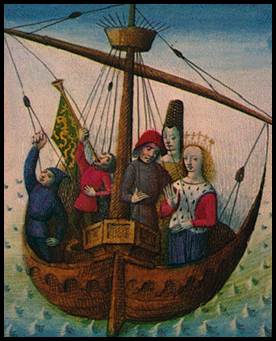Tristan & Iseult: A Jungian Interpretation
The abstract and reference of the essay, published in Dutch.
 Abstract
Abstract
As early as the sixth century bards travelling through Europe were telling the originally Celtic legend of Tristan and Iseult. This is the legend of Tristan's mission in Ireland to take Iseult with the golden hair to be the bride of his uncle, King Mark Of Cornwall, and of the passionate love that brought them great happiness and immense grief.
Tristan and Iseult's tragic love story has been, and still is, a popular theme in art, literature and music throughout Europe. The question is how the story has come to occupy such an important place in European culture. One way to answer this question is to consider a Jungian interpretation of the legend. According to Jung, literature expresses problems from the collective unconscious. The legend of Tristan contains a number of symbols that, in Jungian vision, are visual manifestations of aspects of the collective unconscious. Interpretation of the tale's symbols will hopefully shed some light on the collective problem that seems to have been troubling European civilization for many centuries.
The major problem presented in the legend is the integration of the feminine side into civilization. Collective consciousness, represented by King Mark, is barely in touch with the unconscious and, in particular, with its feminine aspect, the anima. Tristan, on the other hand, communicates with the unconscious extremely well and he successfully deals with certain undesirable unconscious complexes. Tristan represents a new spiritual attitude in civilization that is capable of integrating the feminine side, Iseult the Blonde, in order to enrich and enlarge the collective consciousness. Unfortunately, integration only happens subliminally, with the unfortunate death of them both.
The legend of Tristan draws a picture of Europe's tragic spiritual civilization in those centuries of harsh and cool diplomacy and military readiness, of its unsuccessful attempts to introduce feminine elements into the male-dominated atmosphere. Failing such an attempt, as in Tristan and Iseult's story, moves Europe's civilization, since it touches collective sorrow.
Tristan's presence in contemporary literature suggests that dealing with the feminine side is still problematic, in such a way that feminine qualities, such as sophistication, responsiveness to irrationality, communication with nature and the unconscious, are still not ideally developed.
Originally published in Dutch in Tristan and Isold. A Jungian interpretation. The Annual of the Interdisciplinary Association of Analytical Psychology 1997, edited by Dr J.C. van Meurs.
Illustration: Comment la reine Yseult délivre Tristan de la prison où le roi Marc l'avait fait mettre. Maitre Luces, fifteenth century miniature, Chantilly.


